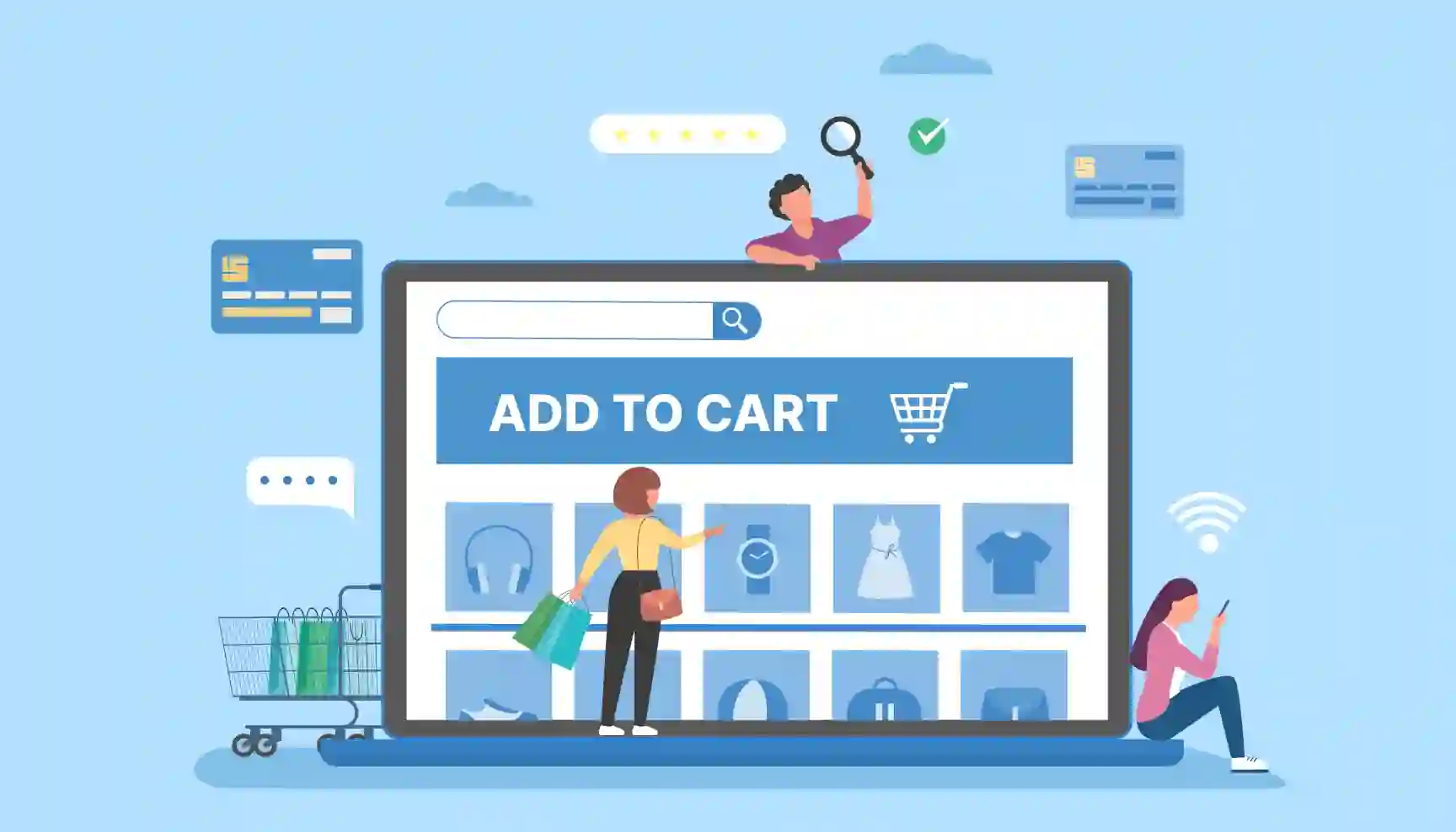E-commerce is the most popular way to trade products and services. Today, more and more people are choosing to purchase publications through the Internet and other assistive technologies.
Social media, advances in eCommerce app development, growing demand for mobile shopping and other digital modalities are the key elements driving this e-commerce revolution.
With sales of US$63 billion in 2021, India would rank eighth in terms of eCommerce markets, ahead of Indonesia and behind France.

The Indian eCommerce market grew by 26% in 2021, contributing to the 15% global growth rate.
Global eCommerce sales are anticipated to grow over the next few years, much like they did in India.
Over the next few years, global expansion will continue as new markets develop.
East and Southeast Asia, with their expanding middle class and lagging offline infrastructure, will be the driving force behind this progress.
India is even anticipated to beat the world average of 6% between 2021 and 2025, with an annual growth rate of 10%.
Source: ecommerceDB
The E-Commerce Market growth Globally

The e-commerce market is anticipated to develop at a CAGR of approximately 26.55% and reach a market worth of $58.74 trillion by 2028, according to SkyQuest.
Unsurprisingly, the number of internet shoppers is quickly increasing. Online shoppers increased from 1.32 billion in 2014 to 1.52 billion in 2016 to 2.14 billion in 2021, a 28% rise in only five years.
This trend will continue as more customers use the internet for their shopping requirements. Interestingly, although accounting for a sizable portion of total retail expenditure (27% in 2021), e-commerce is not expanding as swiftly as traditional retail sales (32%).
Source: Globenewsire
What are E-commerce applications?

E-commerce applications is a bit confusing phrase, as it leads to two different perceptions: one where it refers to the use of e-commerce as a marketing medium; retail and wholesale; auction; electronic banking services; books, and so on.
The second concept that comes to mind is a program like Amazon. It can be a web application or e-commerce applications (now popularly known as m-commerce applications). Mobile e-commerce apps are just an extension of e-commerce. Mobile app concepts are the driving force behind any successful business app, be it a taxi booking app or a meal delivery app.
eCommerce App Development in the last 3 years

In recent years, e-commerce has developed into an essential part of the world’s retail scene.
Following the development of the internet, the retail environment saw a significant shift similar to that of many other businesses.
As a result of the increasing digitization of modern life, customers from almost every nation today benefit from online purchases.
With about five billion people using the internet worldwide, internet usage is growing quickly. As a result, more and more individuals are now making online payments.
The global value of e-retail sales topped 5.2 trillion dollars in 2021, and in the years to come, this sum is only anticipated to increase.
After Club Factory’s removal from app stores in the middle of 2020 slowed growth, Daily Active Users (DAU) growth in India’s top shopping Apps has accelerated in the last three quarters.
In Q2 2021, the top 10 Apps each had more than 7 million Daily Active Users (DAU), an increase of 18% from the previous quarter.
In fact, the removal of Club Factory in Q2 2020 significantly lowered the average MAU (Monthly Active Users) among the top Apps in India. However, early 2021 saw a recovery in India’s active user growth.
The report also points out that fewer shopping apps were downloaded in India at the beginning of the pandemic, with a notable decrease in April and May 2020.
However, the nation experienced significant year over year growth in July and August 2020, and it continued to grow above 2019 levels throughout the remainder of the year and into 2021.
In July 2021, India’s shopping app installs increased once more, surpassing 80 million, up more than 15 million from the previous month.
Source: Statista
eCommerce App Development in the Next 3 years

The COVID-19 pandemic has not only accelerated the growth of brands and e-commerce platforms, but also changed the way people perceive them.
E-commerce has been given a new lease of life as more and more shoppers of different age groups have started to warm up to the idea of shopping online, be it groceries, clothes or shoes, or even services.
In fact, a recent report by MAAS titled “The Dawn of the New-Age Shopper in the New Normal” in collaboration with Sensor Tower shows that the Indian e-commerce industry is set to grow by 84%, accelerated by the pandemic to $111 billion by 2024.
From 2022 to 2025, eCommerce market revenue is anticipated to rise at a 14.90% annual pace, with a projected market volume of $1.3 trillion by that year.
The total estimate for the market for eCommerce software applications is that it would surpass $1.2 billion by 2025.
These numbers show that there is a sizable market to explore in the eCommerce app development, which can propel your company’s growth to new heights.
Modern software and apps with b2b eCommerce features can boost sales, create a loyal customer base, and provide your company a competitive edge in the retail industry.
Source: Indiaretailing
Advanced Characteristics for a successful eCommerce App Development

More than 48% of online shoppers rely their evaluation of an eCommerce store’s legitimacy on its features and mobile-friendly designs, which has a significant effect on the possibility that a lead will turn into a customer.
1. Advanced search functions
This function is intended for online stores with a large catalogue of products. You need to make sure users find what they’re looking for.
Implementing advanced search features such as sorting and filtering dramatically reduces the number of steps a customer has to go through to find their product without browsing the entire store.
It will definitely increase the conversion rate and provide a positive customer experience.
- Augmented Reality
One way to present your product to the customer in a real context is what augmented reality gives your e-commerce application.
It’s been around for a long time, but brands like IKEA have normalized augmented reality in the world of e-commerce. Having a virtual try-before-you-buy experience is a plus.
Customers have found augmented reality very useful when shopping online, as it helps eliminate doubts and hesitations before making a purchase.
It also helps reduce churn because experiential interactions empower customers to make conscious choices.
63% of consumers loved using augmented reality as part of their online shopping journey.
- Personalized customer experience
Once your customers have finished viewing your interesting products and completed their purchase, you should provide them with relevant product offers and recommendations.
Many retailers today use advanced recommendation engines to drive personalization.
It’s easy to draw the customer’s attention to products, offers and discounts that suit their tastes, leading to a likely conversion.
Personalized content also helps increase business reach and customer engagement with the brand.
This, in turn, builds customer loyalty and encourages customers to revisit your online store.
Personalization has been around for some time, but harnessing the power of personalization in ecommerce shopping apps is critical.
- AI voice assistant
Voice shopping is still in its infancy and big names in the e-commerce industry are experimenting with it and pushing the boundaries for a better customer experience.
The possibilities are endless and limited only to the creativity of the retailer.
The technical capabilities of AI-enabled voice assistants help customers easily navigate the app and lead to successful conversions even when the user has usage restrictions.
Therefore, it is obvious that voice assistants are here to stay and will be a beneficial feature to add to your e-commerce application.
- Livestream Feature for Shopping
The live broadcast feature of the products is one post-pandemic essentials that has changed how internet buying is done now-a-days.
Social media giants like Instagram and YouTube were the first to popularize live streaming.
Typically, during a live stream, brands present their goods from a variety of profiles and pin a link to them on the screen.
By 2022, live streams will have ten times the conversion rates of eCommerce website features.
This feature, also known as live commerce, is anticipated to grow threefold and reach $35 billion by 2024.
- Connected TV Advertising
One of the rising updates in the eCommerce sector has been the CTV, sometimes referred to as Connected TV advertising, is transforming the marketing environment for brands.
Because of Apple’s iOS 14.5 update and Google’s devaluation of third-party cookies that happened, eCommerce business platforms are searching for new ways now to connect with their target audiences while maintaining privacy standards.
They have a new performance channel which is known as CTV advertising.
As found by a recent study, 39% adults globally use CTV devices to watch videos and 82% of TV households have at least one linked TV device.
This is how you can capture the chance and transform CTV advertising into your new performance channel as a feature of your improved eCommerce platform.
- Headless Business
In the modern day, digital agility for eCommerce applications is essential to staying competitive.
The features of eCommerce apps must adapt to the constantly changing shifts in customer behavior, which is why it’s better to have added headless features to provide a seamless user experience.
Forbes reports that a staggering $1.65 billion in funding has been raised for headless technologies, which shows how popular they have become over the last two years.
The eCommerce app’s headless architectural feature enables APIs to transmit data in real time between frontend and backend processes, systems, tools, and the user at the center.
What are the advantages of an e-commerce mobile application?

You may have asked for all the above statistics why customers prefer mobile applications when buying online?
How does the experience of mobile purchase differ from that of a mobile browser or an office site?
Well, they don’t put much emphasis.
Today, we are here to discuss with you what users buy on e-commerce applications and why you should choose the development of an online store. So let’s start.
Lower Costs
Undoubtedly, having an online store is an inexpensive affair compared to having a physical store, which is a big benefit of e-commerce.
You are not required to establish your business, pay rent, or hire several employees.
Campaigns done for marketing and advertising are also very affordable.
Internet gateways are also mechanized and computerized, saving a lot of money.
One of the main advantages of online trading is the lack of middlemen, leading to significant cost savings.
The platform establishes a direct relationship between customers and suppliers, thus creating an effective supply chain.
Speed and Adaptability
In a matter of days, anyone or any company can create an online store.
Contrarily, a physical store will obviously need a location first, then a commercial lease, and enough preparation time before starting.
On the other hand, displays and product lines can be altered instantaneously on an e-commerce platform, but in a real store, this calls for meticulous planning, huge amounts of time, and a large staff.
In terms of variety and speed, e-commerce sites perform far better than physical stores, which is thought to be a major aspect of e-commerce.
The seller is able to keep an eye on all operations from the comfort of his home and availability without having to rent any office space.
Access to the customer data
The simplicity with which consumer data can be gathered, analyzed, and used to take appropriate action is another advantage of internet selling that you may not have thought about.
It’s necessary that the consumer data be controlled if you want to have a laser-like focus on the customer experience.
You can easily gather first-hand data via online selling by keeping your eye on customer experiences.
Customer preferences are important, and an online business would track and assess how frequently a customer makes purchases or browses other items on his portal.
But that’s kind of not possible for stores with physical locations.
Customers’ behaviors can be directly and indirectly tracked by sellers, who can then modify their items to fit each customer’s specific needs.
Boosted Profitability
Compared to the traditional or the old-fashioned retailers, opening and running an online store is quite inexpensive.
Additionally, you’ll also spend less on marketing, labor, and overhead.
The majority of the e-commerce apps give the dashboard an added feature for reporting and bills to aid in business financial management.
Costs which are related to the inventory management are also decreased when operating an online store.
Online shops will sell goods more quickly and profitably since they are open twenty-four hours a day, seven days a week.
An key benefit of an e-commerce platform has shown to be the ability to assist businesses increase their profit margins through higher revenues and cheaper prices.
E-Commerce App Monetization

App monetization, to put it simply, is how apps generate revenue.
There are several methods to achieve this when you are trying to make money from the users of your app.
The kind of app a developer creates has a significant impact on the sort of method they employ to make money from customers.
While certain categories may benefit from adopting a combination of tactics to optimize their profits, others may be better suited to particular monetization approaches.
Commission charged
On the basis of the transaction, e-commerce apps charge commission (in percentage).
Before paying the vendor, the commission is subtracted from the transaction value.
For instance, they charge between 2% and 5% for branded products with poor margins, including TV and cellphone. another 10% to 25% on high margin items like clothing and mobile accessories.
Owned delivery services
Many companies provide their own delivery services, such as ATS for Amazon and Ekart for Flipkart.
According to the weights and item price, they assess fees. Before giving the money to the seller, the fee is once more subtracted from the transaction.
For example, the majority of them charge around 50 rupees for anything under half a kilogram. So, you can also opt for the same to have that extra profit
Offer Warehousing
Some online markets, including Amazon, Flipkart, Snapdeal, etc., provide order processing and warehousing.
They set their prices based on how much room the seller’s products require.
Late fine
Then there are fines, late charges, etc. If any vendor misses a shipment date or something comparable, they will incur fees (many of them).
Charges for using payment gateways
Some, like Snapdeal and eBay, impose fees for using their payment gateways, such as Paisapay, etc. either a flat fee or a percentage could apply.
In-app purchases
One of the most popular methods for monetizing mobile apps is through in-app purchases.
In-app purchases are essentially used by Amazon, Flipkart, and practically every other popular e-commerce app.
Affiliate promotion
The most active and invasive way to explore more monetization opportunities is through affiliate marketing.
Here, you may cross-promote your products and create leads by working with other, similar vendors.
Entering into mutual contracts based on various models for shared advantages is one approach to accomplish this.
You can also ask your suppliers to run campaigns on their own platforms or to promote your app alongside their brands on various digital channels.
Based on the enhanced combined perception you design for your business associating with the other brand, these promotions can lead to powerful brand value development and assist you build a respectable user base, taking you far and high in gaining significant monetization benefits for your M-commerce firm.
Return on investment on eCommerce App Development

Consumers throughout the world deal with a significant gap between the amount of time spent on mobile devices and mobile conversion rates.
Although mobile users are more engaged, they purchase more frequently on desktop.
It’s possible for the so-called “mobile gap” to reach 49%. Retailers should use conversion rate optimization in their eCommerce to close this gap.
This entails increasing TTI and page speed overall, delivering a consistent user experience across all touchpoints, and making the most of smartphone capabilities.
Progressive Web Apps can easily enhance many of them.
Of all the PWA case studies we’ve seen, the average conversion rate increase for mobile users was 36%.
For a retailer that earns $5 million per year from mobile devices, revenue from a PWA adds another $1.8 million per year.
Even with a conservative 25% margin, that’s another $450,000 in pure profit after one year.
If you’re very conservative and use a 20% uplift in conversion and a 20% margin, you’ll get $1M in additional revenue and $200,000 in pure profit. Positive ROI after 9 months.
Source: Divante
How to develop an E-Commerce App with the help of Poulima Infotech

Ideation and some Market Research
Everything starts with a thought. If you plan to invest in the eCommerce App Development, you must become an expert in this field.
The worst error you can make is to believe that your e-commerce product can satisfy the requirements of every user.
So our top priority would be to figure out the users’ online habits, interests, and age through statistics, research, focus groups, interviews, and other methods.
Then we will look into categorizing our target audience using demographics, occupation, lifestyle etc.
Then the crucial step is to keep a track of the industry giants who are working in the same industry.
Wireframing
The next step our dedicated team follows is creating documentation and a framework for the Project.
Drawing detailed sketches of the app in mind aids in completing the process.
This step assists in overcoming any technical limitations that may arise while developing the backend for our application.
Designing
The long-term ROI of proper UX/UI design efforts is greatly increased.
We might as well say that when you have an excellent design and adequate attention, your ROI on all of your investments will quadruple.
The experience in applications must go beyond, and UX UI design is the opportunity to stand out.
Design will be your voice and business identity for your target customers.
Color schemes, visually appealing images, and smooth transitions from one page to another are what make a lasting impression on your customer.
So, our team of some of the best designers do an in-depth research to create a prototype of all the features and functionalities that can be included.
Development
After the design is finished, we produce a functional prototype to verify the assumptions and functionality and clarify the project’s scope.
There are a few phases that the eCommerce app development process took.
The first phase involves developing the app’s fundamental functionality but not testing it.
The majority of the suggested functionality is included in the second stage.
Here, the app or the website is briefly tested, and if the tech team finds any issues, the same are rectified.
Testing
For this, the app is shared to a few people from the target audience to use, and they are then asked pertinent questions.
The feedback obtained is then used to improve the website/application performance, and the process is repeated until the project we work on passes the user acceptance test.
Feedback is of utmost importance while creating e-commerce applications because it allows you to determine what works and what doesn’t for your target audience.
Quality Assurance & Deployment/Launch
Once the e-commerce application is moved from stage to production, we give it a quick test drive to ensure that we ‘re all set regarding the app design, performance and navigation.
Maintenance
Users may discover faults and problems in the maintenance phase that are missed during the first testing phase.
In order to improve user experience and retention, these problems are readily corrected by our dedicated team of developers and designers.
Our team also provides post maintenance support for up to 6 months.
Wrapping Up:

Now that you know how the e-commerce market is going to see a staggering growth in the coming years, don’t immerse yourself into doubts and fulfil your dream of owning an e-commerce app with the help of our mobile app development services.



